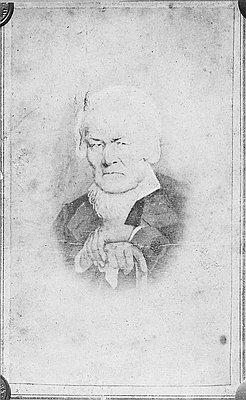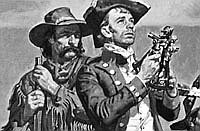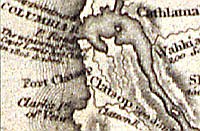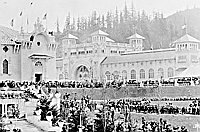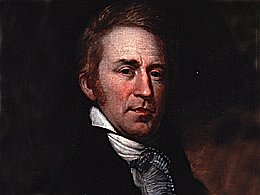Up the Columbia and Back with the Nez Perce
The Corps left Fort Clatsop on March 23, 1806, in a hurry to reach Nez Perce country and cross the mountains that had so tortured them the year before. Ten days of pushing against the Columbia’s current took them to the mouth of the Willamette River, which they had missed entirely on their descent. Clark ascended the river to near present-day Swan Island, where he noted: “at this place I think the wedth of the river may be Stated at 500 yards and Sufficiently deep for a Man of War or Ship of any burthen.” He also learned about the Clackamas River and a major fishing site at the falls of the Willamette. His detailed maps of the region filled in more details about the Columbia’s confusing drainage pattern, but adherence to preconceived geographical ideas led him to imagine the source of the Willamette far south of its origin.
Upstream from the Willamette and past the Sandy River, the Corps struggled against a strong current in the Gorge. Their poor relations with Indians at the Cascades did not improve. On the descent in the fall of 1805, the captains had complained about theft and the Indians’ demands for payments to pass by the rapids. In 1806, tensions increased. At one point, a Corps member drew a knife on an Indian, others stole Lewis’s dog, Seaman, which prompted Lewis to send “three men in pursuit of the theives with orders if they made the least resistence or difficulty in surrendering the dog to fire on them.” The episode ended without violence, but they had more difficulty at The Dalles one week later.
The Columbia’s current forced them to abandon their two pirogues and to seek horses from Indians who demanded high prices—“double that which we had formerly given for those which we purchased from the Shoshonees”—and would give up only four, even though, as Lewis noted with frustration, “they have a great abundance of horse but will not dispose of them.” Lewis lost all patience in his negotiations, railed at pilfering that bedeviled the Corps, and informed the Indians:
I would shoot the first of them that attempted to steal an article from us. that we were not affraid to fight them, that I had it in my power at that moment to destroy them all and set fire to their houses, but it was not my wish to treat them with severity provided they would let my property alone.
By then, Lewis and Clark had abandoned their mission of establishing trade relations with Indian groups on the Columbia. Their need for horses and their eagerness to return to the Plains and the Missouri seemed to encourage their willingness to end trade negotiations and flex their power as an answer to Indian intransigence.
At the mouth of the Snake River, the Corps finally made satisfactory connections with the Wallulas. Chief Yelleppit, who welcomed potential trade in firearms from the Americans, sold them horses and provided directions for an overland shortcut that eliminated what would have been a brutal ascent of the lower Snake to the Nez Percecamps and the horses they had left behind in 1805.
At their old camp along the Clearwater River, the captains reunited with the Nez Perce but found themselves far too early to cross the snow-laden Bitterroot Mountains. With the Nez Perce, Lewis and Clark displayed more patience, realizing that this tribe could well play a significant role in future relations with the United States in territory that it claimed jointly with Great Britain. The Nez Perce offered “that they were pore but their hearts were good [and] we might be assured of their sincerety.” The captains offered to take a Nez Perce representative to Washington, D.C., but Indian negotiators demurred, asking for firearms first. Delayed by nearly a month waiting for the snow to melt in the high country, the Corps camped along the Clearwater and interacted with Indian families, while Clark used his medicine kit to doctor ails among their hosts.
While the Corps settled into Camp Choppunish, their name for the Clearwater resting place, Sergeant John Ordway and two others went on a week-long exploring mission to find a route to the Snake River. Ordway and his companions struck the Salmon River instead, and then looped back to the Clearwater, thereby providing Clark with more geographic information. By the time Ordway returned, the Corps’ eagerness to head east over the mountains led the captains to once again leave a camp too early. On June 17, as Ordway recorded it:
when we got half way up it [mountain trail] the ground was covred with Snow 3 or 4 feet deep as we ascended higher it got deeper until we got to the top of the mountain where it was 12 or 15 feet
Faced with impossible conditions, according to Sergeant Patrick Gass,“we therefore halted to determine what was best to be done, as it appeared not only imprudent but highly dangerous to proceed without a guide of any kind.” Trading one of the “Short rifles,” the Corps secured guidance from two Nez Perce for the trek over Lolo Trail. Reaching the hot springs at Traveler’s Rest on June 29, the Expedition stopped, indulged in a soak to refresh themselves, and prepared for their return to United States territory.
© William L. Lang, 2004. Updated and revised by OHP staff, 2014.
Sections
Related Historical Records
Columbia River from the Cascades to Wappato
This map, sketched by explorer Captain William Clark in early November 1805, shows the Columbia River between the Cascade Rapids and Sauvie Island — which Clark called “Wappato Island” …
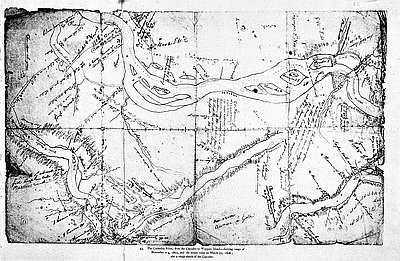
Principal Watercourses West of the Rockies
The document reproduced here is Captain William Clark’s copy of a map sketched by two Nez Perce Indians in May 1806. It shows the principal river systems west …
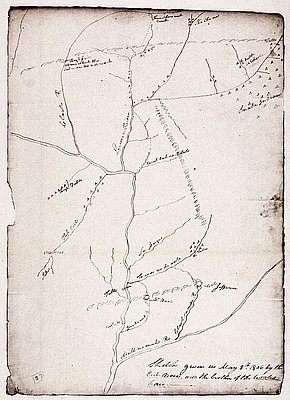
Patrick Gass (1771-1870)
Patrick Gass, a member of the Lewis and Clark Expedition, is shown in this photograph, the original of which was probably taken around 1860. Gass’ left eye, which he …
